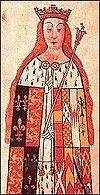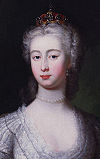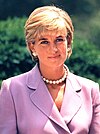Princess of Wales
| Princess of Wales
Tywysoges Cymru | |
|---|---|
 | |
| Style | Her Royal Highness Ma'am |
| Residence | Clarence House |
| Inaugural holder | Joan of Kent |
| Website | princeofwales.gov.uk |
Princess of Wales (Welsh: Tywysoges Cymru) is a British courtesy title held by the wife of the Prince of Wales, who has been, since the 14th century, the heir apparent of the British monarch. The first acknowledged title holder was Eleanor de Montfort, wife of Llywelyn ap Gruffudd. It has subsequently been used by wives of post-conquest princes of Wales.
The title was last used by Diana, Princess of Wales, first wife of Charles, Prince of Wales. Camilla, Duchess of Cornwall, Charles's second wife, is the current princess of Wales but she does not use the title.[1]
Status of the title[]
The Princess of Wales is not a princess in her own right. There have been some Princesses of Wales who were addressed as such: for example, Alexandra of Denmark and Mary of Teck were called "Princess Alexandra" and "Princess Victoria Mary", respectively. However, that was because they were already princesses when they married. Diana, Princess of Wales, was commonly called "Princess Diana" following her marriage to the Prince of Wales, but this was incorrect because she was not a princess in her own right.
Although not granted the title in her own right, the future Queen Mary I was, during her youth, invested by her father, King Henry VIII, with many of the rights and properties traditionally given to the Prince of Wales, including use of the official seal of Wales for correspondence. For most of her childhood, Mary was her father's only legitimate heir, and for this reason, she was often referred to as "the Princess of Wales", although Henry never formally created her as such. For example, Spanish scholar Juan Luis Vives dedicated his Satellitium Animi to "Dominæ Mariæ Cambriæ Principi, Henrici Octavi Angliæ Regis Filiæ".[2]
Other titles of the Princess of Wales[]
The Princess of Wales, by virtue of her marriage to the Prince of Wales, takes on the feminine equivalent of her husband's titles. Thus, upon marriage, the wife of the Prince of Wales assumes the styles and titles of Princess of Wales, Duchess of Cornwall, Duchess of Rothesay, and Countess of Chester.
The Princess of Wales is known as the Duchess of Rothesay in Scotland, and the Prince of Wales is known as the Duke of Rothesay there, the dukedom being the title historically associated with the heir to the Scottish throne. She is known as the Duchess of Cornwall in the far south west of England, and as the Countess of Chester in Cheshire.
Native princesses of Wales[]
Several consorts of Welsh princes of Wales were theoretically princesses of Wales while their husbands were in power. Llywelyn ab Iorwerth's consort, Joan, Lady of Wales, used that title in the 1230s; Isabella de Braose and Elizabeth Ferrers were likewise married to princes of Wales, but it is not known if they assumed a title in light of their husbands' status.
The only consort of a Welsh prince definitively shown to have used the title was Eleanor de Montfort, the English bride of Llywelyn ap Gruffudd, the last native Prince of Wales. Eleanor died shortly after giving birth to their only child, Gwenllian, who was taken prisoner as an infant following her father's death. Gwenllian was the only native Welsh princess to be described as Princess of Wales; Edward I had her raised in Sempringham Priory in Lincolnshire, far from where any Welsh rebels could find her, and once appealed to the Pope to increase funds to the priory by writing that "...herein is kept the Princess of Wales, whom we have to maintain."[3]
List[]
Cecily Neville, wife of Richard, Duke of York, is omitted from this list. Although her husband Richard of York was briefly given various titles, including Prince of Wales, by an Act of Parliament as part of his arrangement to succeed Henry VI as king instead of Henry's own son, he is not generally recognised as such and is not mentioned in any published summary of the topic.
| Person | Previous name | Birth | Marriage | Became Princess of Wales | Spouse | Change in style | Death | |
|---|---|---|---|---|---|---|---|---|

|
Joan, Countess of Kent | 19 September 1328 | 10 October 1361 | Edward the Black Prince | 7 June 1376 (husband's death) |
7 August 1385 | ||

|
Lady Anne Neville | 11 June 1456 | 13 December 1470 | Edward of Westminster | 4 May 1471 (husband's death) |
16 March 1485 | ||

|
Infanta Catherine of Aragon | 16 December 1485 | 14 November 1501 | Arthur, Prince of Wales | 2 April 1502 (husband's death) |
7 January 1536 | ||

|
Princess Caroline of Ansbach | 1 March 1683 | 22 August 1705 | 27 September 1714 | George Augustus of Brunswick and Lüneburg | 11 June 1727 (husband's accession) |
20 November 1737 | |

|
Princess Augusta of Saxe-Gotha | 30 November 1719 | 17 April 1736 | Frederick, Prince of Wales | 31 March 1751 (husband's death) |
8 February 1772 | ||

|
Princess Caroline of Brunswick | 17 May 1768 | 8 April 1795 | George, Prince of Wales | 29 January 1820 (husband's accession) |
7 August 1821 | ||

|
Princess Alexandra of Denmark | 1 December 1844 | 10 March 1863 | Albert Edward, Prince of Wales | 22 January 1901 (husband's accession) |
20 November 1925 | ||

|
Princess Mary of Teck | 26 May 1867 | 6 July 1893 | 9 November 1901 | George, Prince of Wales | 6 May 1910 (husband's accession) |
24 March 1953 | |

|
Lady Diana Spencer | 1 July 1961 | 29 July 1981 | Charles, Prince of Wales | 28 August 1996 (divorce) then titled Diana, Princess of Wales |
31 August 1997 | ||

|
Camilla Parker Bowles | 17 July 1947 | 9 April 2005 (known as Duchess of Cornwall) |
incumbent | ||||
See also[]
- The Green Howards (Alexandra, Princess of Wales's Own Yorkshire Regiment)
- The Princess of Wales' Own Regiment (Canada)
Notes[]
- ^ Jump up to: a b "House of Commons – Royal Marriage". parliament.uk. Retrieved 7 February 2015.
- ^ "To the Lady Mary, Prince of Wales, Daughter of Henry VIII, King of England" [1]
- ^ Bliss, W. H., editor. Calendar of Papal Registers Relating To Great Britain and Ireland: Volume 1, 1198-1304. Her Majesty's Stationery Office, London, 1893.
Bibliography[]
- Princesses of Wales by Deborah Fisher. University of Wales Press, 2005.
- 'Tystiolaeth Garth Celyn' Y Traethodydd 1998 ISSN 0969-8930
Further reading[]
- Fryer, M.; Mary Beacock Fryer; Arthur Bousfield; Garry Toffoli (1983). Lives of the Princesses of Wales. Toronto: Dundern Press Limited. ISBN 978-0-919670-69-3.
- British monarchy
- Lists of princesses
- Princesses of Wales
- Titles
